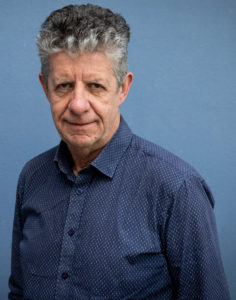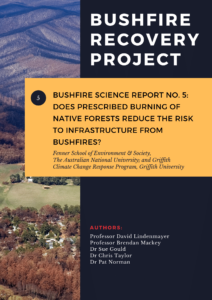Prescribed burning can reduce house loss during bushfires so long as it is targeted close to houses, the latest review by the Bushfire Recovery Project has reported.
“The effectiveness of fuel reduction burning, however, is greatly reduced on high fire danger days and we’re experiencing 10 times as many high fire danger days as we were in the 1960s,” said Professor Brendan Mackey, Griffith Climate Action Beacon Director and a coordinating lead author for the International Panel on Climate Change.
This is one of many key findings of an expert review of 72 scientific papers about bushfire and infrastructure loss by the Bushfire Recovery Project, a joint initiative between Griffith University, the Australian National University and the Great Eastern Ranges Initiative – a community-based conservation NGO.

Professor Brendan Mackey, Director of the Griffith Climate Action Beacon and Griffith Climate Change Response Program
The report is the last in a series by the Bushfire Recovery Project, established with philanthropic co-investment from the Griffith Climate Change Response Program to use a sound scientific understanding of critical forest fire issues in an era of climate change to inform post-fire forest management.
It is hoped that the impact of this philanthropic support would be felt for years to come by communities around Australia and potentially overseas as more funding is sought to expand the regions covered.
The Bushfire Recovery Project also analysed satellite data to map the 2019—2020 Black Summer bushfire footprint, including the fire intensity and developed an app that enables bushwalkers, members of land care groups, amateur naturalists, rangers, etc., to upload to an interactive map of observations of the forest regrowth, habitat features and wildlife following the fire.
The key findings of their latest report were:
- To reduce loss of houses and other buildings/infrastructure, the location of fuel reduction burning is much more important than the number of hectares burned;
- Prescribed burning is effective when very close (<1km) to houses, however is only effective for around five years;
- The effectiveness of controlled burning is likely to go on decreasing substantially as the climate continues to heat, due to the reduction in winter rainfall in southern Australia with climate change, the drying the fuel load, the hotter springs and the lengthening the fire season;
- Most house losses occur on days when the fire danger rating is severe or higher and;
- Australia is now experiencing 10 times the number of extreme fire danger days it experienced annually it in the 1960s — 143 in 2010s versus 14 in the 1960s.

Bushfire Recovery Project Report No. 5 on the effectiveness of prescribed burning of native forests
The Bushfire Recovery Project reported previously that fuel load dryness is much more important than the amount of fuel.
Professor Mackey said the evidence was that targeted fuel reduction burning of relatively small areas was most effective.
“Targeted burning within 1 km of houses and towns can help to protect them from bushfire, but it must be done every three years.
“The evidence shows fuel reduction burning was once much more effective than it now is, because we faced far less extreme fire weather 50 years ago.
“There has been an irreversible change in fire weather conditions since the 1970s – put simply, the game has changed.”
ANU Bushfire and Landscape expert Professor David Lindenmayer AO agreed the climate was now completely different to what it was in the 1970s and that the effectiveness of fuel reduction burning was hugely reduced on these very hot days.
“The peer-reviewed evidence is that burning forest miles from houses doesn’t protect those houses,” Professor Lindenmayer said.
“Multiple strategies are needed to reduce the risk of infrastructure loss due to bushfire, but even then, the risk of losing houses and infrastructure to bushfire in Australia can be reduced, but not eliminated.

